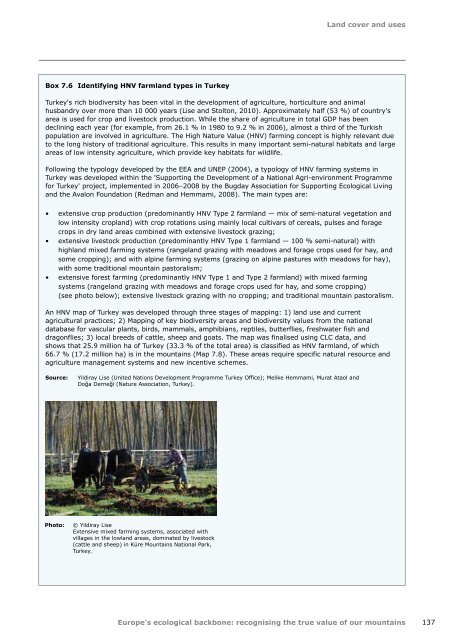Europes ecological backbone.pdf
Europes ecological backbone.pdf
Europes ecological backbone.pdf
Create successful ePaper yourself
Turn your PDF publications into a flip-book with our unique Google optimized e-Paper software.
Land cover and uses<br />
Box 7.6 Identifying HNV farmland types in Turkey<br />
Turkey's rich biodiversity has been vital in the development of agriculture, horticulture and animal<br />
husbandry over more than 10 000 years (Lise and Stolton, 2010). Approximately half (53 %) of country's<br />
area is used for crop and livestock production. While the share of agriculture in total GDP has been<br />
declining each year (for example, from 26.1 % in 1980 to 9.2 % in 2006), almost a third of the Turkish<br />
population are involved in agriculture. The High Nature Value (HNV) farming concept is highly relevant due<br />
to the long history of traditional agriculture. This results in many important semi-natural habitats and large<br />
areas of low intensity agriculture, which provide key habitats for wildlife.<br />
Following the typology developed by the EEA and UNEP (2004), a typology of HNV farming systems in<br />
Turkey was developed within the 'Supporting the Development of a National Agri-environment Programme<br />
for Turkey' project, implemented in 2006–2008 by the Bugday Association for Supporting Ecological Living<br />
and the Avalon Foundation (Redman and Hemmami, 2008). The main types are:<br />
• extensive crop production (predominantly HNV Type 2 farmland — mix of semi-natural vegetation and<br />
low intensity cropland) with crop rotations using mainly local cultivars of cereals, pulses and forage<br />
crops in dry land areas combined with extensive livestock grazing;<br />
• extensive livestock production (predominantly HNV Type 1 farmland — 100 % semi-natural) with<br />
highland mixed farming systems (rangeland grazing with meadows and forage crops used for hay, and<br />
some cropping); and with alpine farming systems (grazing on alpine pastures with meadows for hay),<br />
with some traditional mountain pastoralism;<br />
• extensive forest farming (predominantly HNV Type 1 and Type 2 farmland) with mixed farming<br />
systems (rangeland grazing with meadows and forage crops used for hay, and some cropping)<br />
(see photo below); extensive livestock grazing with no cropping; and traditional mountain pastoralism.<br />
An HNV map of Turkey was developed through three stages of mapping: 1) land use and current<br />
agricultural practices; 2) Mapping of key biodiversity areas and biodiversity values from the national<br />
database for vascular plants, birds, mammals, amphibians, reptiles, butterflies, freshwater fish and<br />
dragonflies; 3) local breeds of cattle, sheep and goats. The map was finalised using CLC data, and<br />
shows that 25.9 million ha of Turkey (33.3 % of the total area) is classified as HNV farmland, of which<br />
66.7 % (17.2 million ha) is in the mountains (Map 7.8). These areas require specific natural resource and<br />
agriculture management systems and new incentive schemes.<br />
Source:<br />
Yildiray Lise (United Nations Development Programme Turkey Office); Melike Hemmami, Murat Ataol and<br />
Doğa Derneği (Nature Association, Turkey).<br />
Photo:<br />
© Yildiray Lise<br />
Extensive mixed farming systems, associated with<br />
villages in the lowland areas, dominated by livestock<br />
(cattle and sheep) in Küre Mountains National Park,<br />
Turkey.<br />
Europe's <strong>ecological</strong> <strong>backbone</strong>: recognising the true value of our mountains<br />
137

















